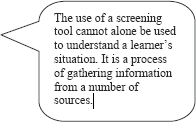Benefits of using screening tools
The following information was taken from the National Adult Literacy and Learning Disabilities Center - "Screening for Adults with Learning Disabilities" written by Adrienne Riviere:
- Screening helps practitioners to help the learners understand their strengths and weaknesses and the possible reasons behind their difficulties
- The informal nature of the screening process enables practitioners to include learners in determining tools, instructional preferences, materials and strategies
- Screening may help practitioners to determine which strategies or interventions have been previously tried by the learners (if any)
- Screening can lead to discussion between the practitioner and the learner about realistic goals and short-term outcomes.
The National Institute for Literacy - The Southern Lincs (http://ldlink.coe.utk.edu/) is a website which provides some excellent information on screening tools under the section entitled "Assessment." Here you can find further information on The Role of Screening, Screening versus Diagnostic Testing, Determining When to Screen, The Screening Process and Screening Tools and Instruments.

Screening Toolbox
Practitioners can access a number of screening tools to help identify potential learning disabilities, gain further insight into challenge areas, and gather an understanding of learners' strengths and weaknesses to build an effective training plan.
Screening tools may include:

- Additional questions to integrate into current intake process
- Checklists to help guide practitioner observations
- Learner self-assessment inventories
- Tools to help determine if a formal assessment should be pursued and/or tools to help determine challenge areas
- Checklists to help guide practitioner assessment of learner work samples
The screening tools selected will depend on:
- Learner input
- Learner goals
- Program resources
- Practitioner skills and knowledge
- Ongoing assessment results of learner progress